The Role of Blacks in The Decline of The US Midwest and Manufacturing
Executive Summary
- In nearly all media, blacks are framed as the victims of the decline of manufacturing in the Midwest.
- This article proposes a different explanation that has to do with blacks themselves.

Introduction
This article will use several important graphics to counter the generally accepted explanation that blacks have nothing to do with the US Midwest’s decline and manufacturing in the Midwest. After reviewing the evidence, you may agree that it is clear this explanation has not been provided due to people censoring themselves, as the conclusion is not politically correct.
The Standard Explanation for The Decline of Detroit and Other Midwestern Cities
Videos like this will never bring up the fact that what happened in Detroit happened in every city in the US where blacks have become predominant. A significant limitation in the analysis of what has led to the decline of so many cities where blacks have become predominant is that every city is treated as if it is in isolation from other towns. This same issue applies to the overall Midwest.
This “isolated analysis” of cities in the US Midwest is found at the beginning of the above video. Here is the quote from the 0:28 mark in the video.
Most cities in the Rust Belt have experienced a population decline, including Buffalo, Cleveland, Cincinnati, Chicago, St Louis. All of these have experienced major population losses.
City Example #1: Buffalo
All of these cities also developed large black populations. For example, Buffalo, NY, is not generally thought of as having a large black population — however, look at the following graphic showing demographic changes.

In 1940, Buffalo was 96.8% white, with only 3.1% of the population being black. However, by 2023, non-Hispanic whites make up only 44.7% of the population and 33.3% black. There is no city in the country where 1/3 of the population is black, which is also considered a desirable city.
The video also makes the point that American car manufacturers became less dominant with the arrival of Japanese cars and other changes to the automotive industry in the US. However, this explanation misrepresents when car companies began moving factories out of the city of Detroit — which was decades before the Japanese cars penetrated the US market — which was in the 1970s. Observe the following graphic.
City Example #2: Detroit
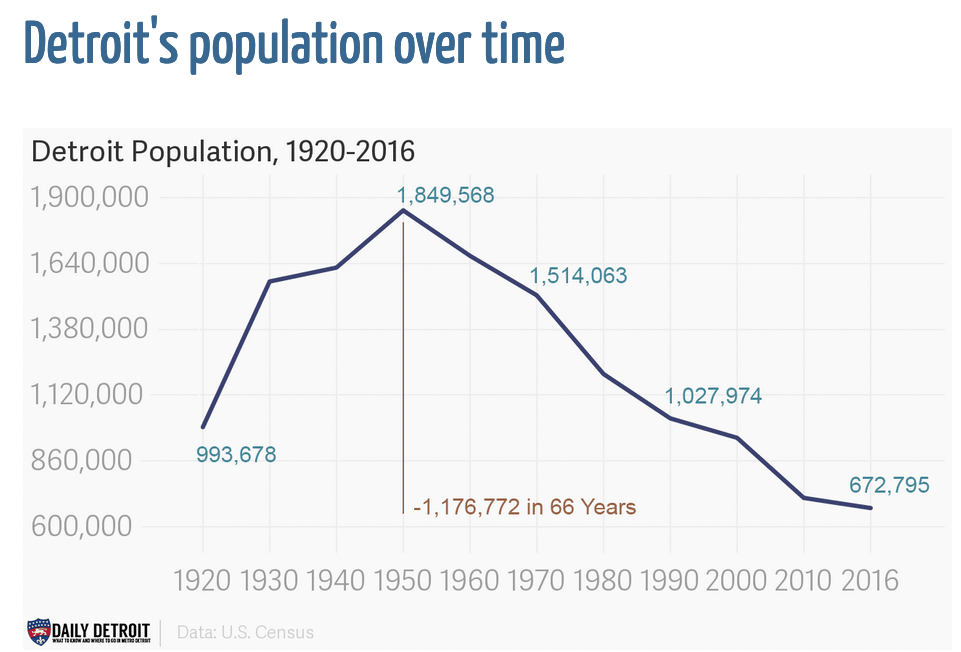
The peak of Detroit’s population was in 1950. This was the pinnacle of the success of the US car industry. And the groups that primarily left — significantly decreasing Detroit’s population were white. Both car manufacturers and the population moved out of Detroit before the significant changes to the car companies and foreign competition began.
In 2023, Detroit is roughly 80% black. The long-term pattern in all of the cities of the Midwest is for the population to decline, for it to be primarily white flight, and then for the town to be left with a substantial black population. Without a sufficient white population or whites vastly outnumbering blacks, no history of any town flourishing exists.
In 1967, the black riots promoted even more whites to leave, as is explained in the quote from the article The Effect of The Decline of Manufacturing on the Black Middle Class.
In the aftermath of Detroit’s polarizing 1967 riots, the steady stream of white residents who were already leaving the city turned into a torrent. Yet many middle-class blacks opted to stay behind. Most of the suburbs remained off limits to African-Americans; what’s more, the 1973 election of Detroit’s first black mayor, Coleman Young — himself a former Ford line worker — seemed like cause for renewed optimism. But in the 1980s, as crime rates soared, the quality of schools and services plummeted and the number of crack houses multiplied, more and more middle-class blacks abandoned the city for the suburbs, or in some cases, left the Detroit area altogether.
Why? Well — most of the whites left, and Detroit became increasingly managed by blacks. Everything listed is the inevitable outcome of when blacks are not allowed to benefit from a white-run and white predominant society and when they are predominant.
Comparing the Similarities of What Happened to Detroit to Gary
The best way to understand what happened in Detroit is to look at a graph of the same thing in Gary, Indiana. Gary and Detroit are not two different stories. They are the same story.
- Step #1: White develops a city.
- Step #2: Blacks move to the city to gain employment opportunities.
- Step #3: The city has been sustainable for decades, but the black population continues to rise.
- Step #4: At a certain point, the growth of the black population over-strains the white society — and then white flight takes over. White flight is continual — and it eventually leaves the black population as the highest percentage of any group in the city. The city increasingly becomes a recipient of federal aid. At this point, the town becomes a permanent drain on federal resources, pulling more from the federal government than it pays in taxes.
- Step #5: Without whites or with far fewer whites, the black population is unable on their own to replace what the whites created, and the city goes into a doom loop.
City Example #3: Gary, Indiana
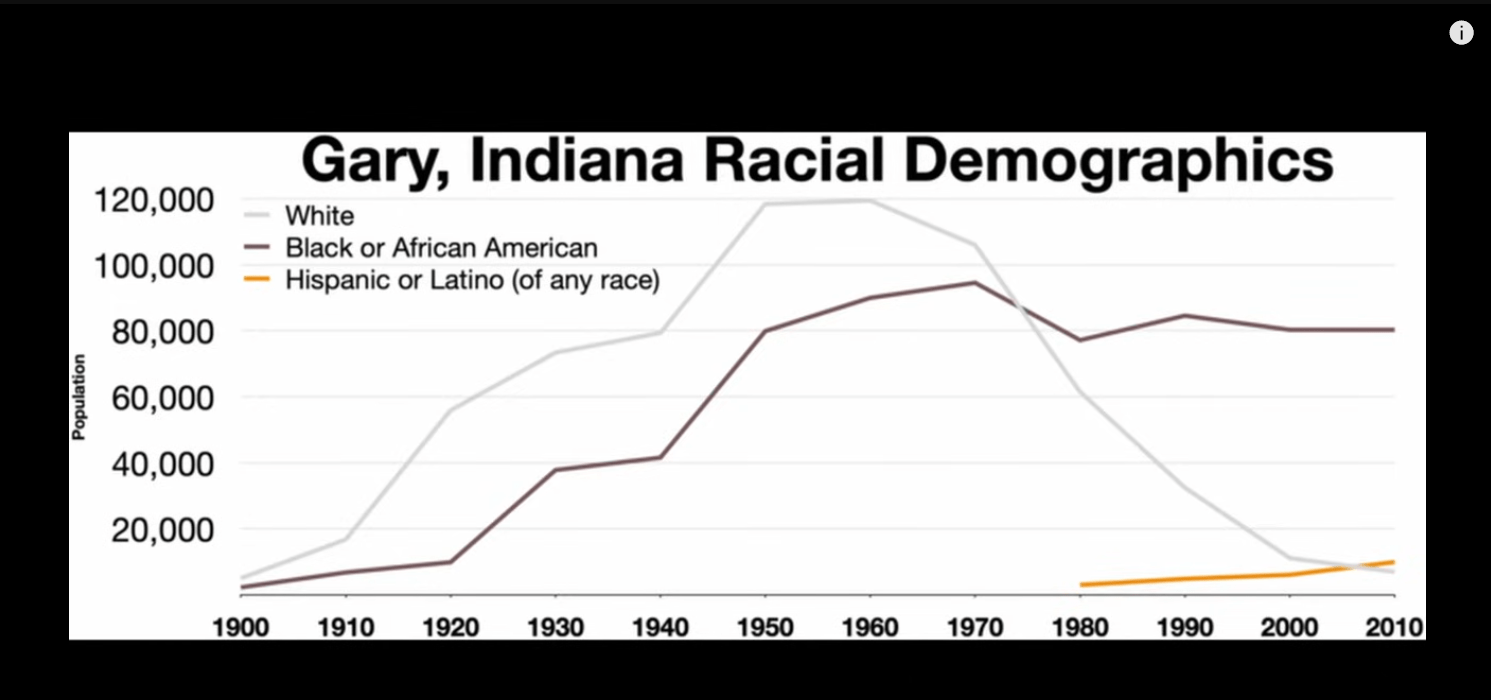
This graphic shows the white population growing before the black population. This is the norm. Whites will build up a city, and the blacks are drawn to the town for employment. Blacks and whites increased significantly from 1940 to 1950, but after the 1950s, there was no more growth in the US population. The white population stabilizes, and then — as the black population continues to rise, there is a slight decline from 1960 to 1970. Now, the black and white populations are nearly equal at nearly 90,000 for each. After this point, the white population declines steeply, dropping to around 13,000 by 2000 and 7,000 in 2010. some blacks also moved away, but the majority stayed. Gary is in 2023, just like Detroit, 80% black) Gary, Indiana, is now considered a horrible place to live for decades.
It should be noted that there is no example I am familiar with where the pattern above works in reverse or the opposite way. That is there is no example of a city that is built up by blacks, and then whites move there to benefit from the employment. Then, the black employers and black population leave the city, and the town then falls into disrepair and becomes a significant recipient of government welfare.
How Gary Indiana Was Cut Off From A Close By City by That City
As is shown at the beginning of this video, a city nearby Gary named Hammond decided to wall off a road so that blacks from Gary would not visit their city. I have never seen this before. However, this shows what happens when a city becomes nearly entirely black. Any city that can keep blacks from visiting and particularly moving to their city will be much better off.
This is the logic for redlining, as I cover in the article What is Wrong With Whites Engaging in Redlining?
Notice in this article that there is no mention that the decline of the city was due to the city being dominantly black, and this caused Gary to become a hellhole. People do not feel like they are comfortable making this obvious statement. The goal of such videos is to try to blame anything except blacks.
At the 7:30 mark in the video, it states the following.
Black residents were proud of their city and happy to have some measure of political control. Its unfortunate that this change in political landscape is the exact moment that US Steel began to layoff workers.
Was it unfortunate or predictable? Notice that this, as with all explanations I have read, attempts to make it sound as if the company’s decline has nothing to do with the rise in black workers at the companies in Gary, Indiana. However, if this same thing is repeated in countless cities, and companies begin to decline when blacks become a significant percentage of the population in a city — then blacks increasing as a population must be considered a factor. The only reason it is not considered a causal factor is that the person who brings up this obvious point will be called a racist and be ostracised. This demonstrates that humans are very good at being dishonest and changing the causes they see as explanatory based upon the personal cost to themselves.
In the first part of the above quote, it states that black residents were happy to have some measure of political control. However, there has never been a case where blacks having some measure of political control has led to better outcomes. Black cities in the US are the most corrupt and poorly run cities in the country. The companies and people of Gary, Indiana, had a legitimate concern that as soon as black politicians began to be elected, the city would move into a doom loop. It was rational for non-blacks and companies to leave Gary then. The successful history of Gary was when Gary was almost entirely white — or when blacks were in the minority. As soon as a sufficient percentage of blacks were the population of Gary, the city began the standard black city doom loop.
At the 7:50 mark of the video, it states.
Gary’s steel mills began to fall victim to de-industrialization. This is when one region’s industries decline as it becomes cheaper to import the same goods from someplace else. This phenomena stuck the entire rust belt hard, but perhaps none as hard as Gary. Production had picked up in the 1980s and 1990s, but automation had rendered most jobs obsolete.
This assumes that there was no change to the factories when many black workers were hired. However, blacks are known as poor workers — which is a reason they are discriminated against. It is very difficult to believe that the US Steel factory in Gary functioned as well with black workers as it had when the workers were predominantly white. Furthermore, the motivation of the white workers would also have been negatively impacted as they would have had to work with blacks and then live in a black city. Again, in earlier years, the number of blacks was far fewer, but as the number of blacks continually increased, it would have created natural problems. All of this is left of the video, which assumes that productivity would have stayed the same as blacks became a much larger percentage of factory workers and that the reduction in jobs was entirely due to external factors.
Gary’s was highly concentrated in steel production — however, so was Pittsurgh’s. The steel mills in Pittsburg experienced the same international competition, but Gary, not Pittsburg, became a hellhole. Why? Well, which city had the highest black population? That would be Gary. Here is a quote from someone on the Gary video.
My mother in law, aged 70 now, grew up in Gary. Lots of interesting stories. Her and her brothers used to play with Michael Jackson and one of his brothers when they were younger. She has lots of memories of how dangerous it was even in back in her time. Having to carry a butcher knife to the bus stop early in the mornings and almost getting gang raped while she waited at the library for her brother to pick her up outside. It was rough as far back as she could remember.
Does that sound like something that would happen in a nearly all-white city? Would such behavior have potentially caused white flight from Gary?
And this comment.
Way back in the 1990’s, myself and some friends (all Canadian) were traveling thru the area. We made a few wrong turns and ended up in Gary. Within minutes a cop car approached us. When they found out we were from elsewhere, they immediately escorted us back to the interstate.
And this comment.
We ended up staying in Rockford, Illinois, which, unbeknownst to us at the time, is even worse than Gary! We spent a rather nervous night in a hotel there and got the hell out as early as possible.
City Example #4: Rockford Illinois
I looked up Rockford’s demographics, and they are as follows:
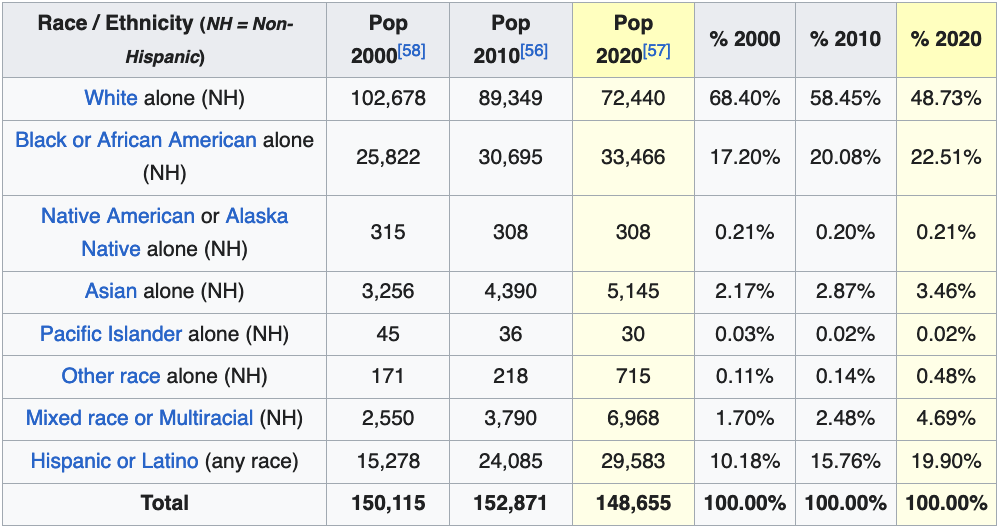
With a population of only 48.73% white, 22.5% black, and roughly 51% non-white, Rockford will not be a nice city with this demographic combination.
Rockford as a Slum
At the 34-minute mark in this video, a local black man is asked when he really saw Rockford change for the worse — which he said was the early 2000s.
Isn’t that interesting? In 2000, Rockford was 68% white and 17.7% black. Now in 2020 it was 48% white, but 22.5% black and rose from 10% Hispanic to nearly 20% Hispanic. There are far fewer whites to make the city nice. The whites who are left are less interested in investing in the city, and each year, more of them leave. By 2024, all of these statistics are worse.
As with all the other cities covered in this article, the white population has steadily decreased.
Towards the 35-minute mark in the video, the discussion again turns to manufacturing leaving and entirely leaving out the demographic turnover of Rockford. Can you imagine the host asking, “Do you think that the whites leaving and the city becoming roughly 42% black and Latino has anything to do with it?
As is always the case, Rockford was founded and built in the 1830s by whites — and then degraded quite recently by non-white immigration into the city. Rockford never had today’s problems from the 1830s until the demographic changed.
See this quote from Wikipedia.
In a decision that continues to affect Rockford to the present day, in 1989, Rockford Public School District 205 closed several schools across the city in a cost-cutting decision.
Well, the tax revenues have declined with the demo turnover, and blacks and Latinos have more children than whites.
In the aftermath of the decision, the school district was found guilty in federal court of discrimination against minority students. From 1993 to 2001, the school district was under federal oversight to desegregate its schools, costing over $250 million.
Yes, but if you can’t discriminate against black and Latino students and isolate them in schools in their neighborhoods, then they will ruin your schools for whites. Desegregation will mean more whites than leaving Rockford, further eroding the tax base.
Media Cover-Up on the Population Decline of Rockford
Notice that this segment does not mention Rockford’s demographic turnover. Curiously, it is not just Rockford. Every city with a high black or Latino population results in a decline in not only the white population but also all metrics that make a location desirable to live.
At the 1:00 minute mark in the video, the man interviewed says that Rockford should prepare for an influx of people from larger metros. That never happened. Does this supposed expert not realize that Rockford is black and no one, not even blacks, wants to live in a city with so many blacks and with an equal percentage of the population being Latino?
In the same way the previous video on Gary leaves out Gary’s large natural advantages, as is explained in this comment.
Add to that the fact that the lake itself was hugely important for transporting the iron ore because transporting goods on ship is far cheaper for heavy raw materials like this. Iron Ore was being trucked from places like Upper Michigan and loaded onto barges in places like Duluth to be ferried down to Gary. Gary’s location was an incredible one-of-a-kind spot that had all the ideal qualities one would seek for steel production… probably the best location on the planet.
However, once the demographic became black, it overwhelmed the natural advantage of the location of the city.
What is Wrong With the Standard Explanation of What Brought Down US Midwestern Cities?
The standard explanation of what happened to Gary is the same as what happened to Detroit: the industries the city relied on declined. However, what if that is not true? Furthermore, the cities of the Midwest did not just decline; in many cases — such as with Detroit, Gary, and Cleveland — large parts of them are considered to be “no-go zones” for anyone but blacks.
The standard explanation confuses cause and effect. It is not the deindustrialization that occurred, causing the city to decline; it is the black population that rose (along with, in some cases, the Hispanic population), which degraded the city and made the available employees less desirable, leading to deindustrialization. This is very obvious from analyzing every town that had a substantial increase in its black population and a corresponding decrease in its white population.
Furthermore, this same scenario repeated itself not only in US cities but, as you will see further in the article, in cities outside of the US. It occurs in cities with different industries, such as Zimbabwe and South Africa, which have very little manufacturing.
City Example #5: What Happened to Milwaukee?
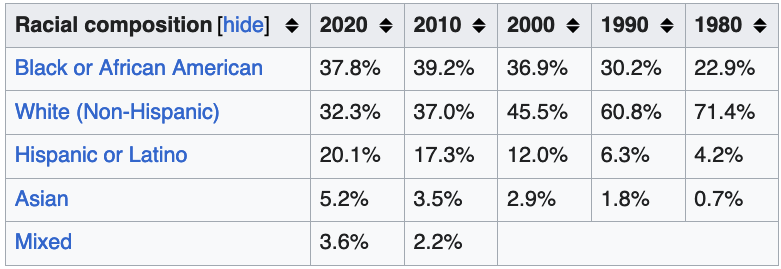
No one talks much about Milwaukee, as it is a city that is off the map, a country that barely anyone talks about. However, the same thing happened in Milwaukee. Milwaukee developed a substantial manufacturing area that was entirely built by whites. Major manufacturing included motorcycles and brewing. These are not industries that went into decline, yet Milwaukee did go into decline. What is the excuse, then, for Milwaukee’s decline?
A look at the demographics shows the same thing happening to other Midwestern cities.
In 1980, the white population was 71.4%, and in 2020, it dropped to 32.3%, while the black population rose from 22.9% to 37.8% by 2020. This timeline only goes back 40 years; however, going back 80 years, one would find Milwaukee almost exclusively white.
Getting Back to The Gary, Indian Racial Demographic Graph

Review the graph on Gary, Indiana, and I will provide my counter-analysis to the establishment explanation. I am using this graph because it is the best I could find on demographic change in a midwestern city. However, this relationship is found in any Midwestern city that significantly declined. It is just that I could not find graphics that are as good as this.
What Happened to Gary, Indiana, as the Black Population Dramatically Rose?
As the black population of Gary continued to rise, a few things happened. First, Gary began to be considered a less desirable place to find employees — as blacks are generally known as poor workers with lower skills and lower intelligence and impulse control than whites. Second, as the black population rose, the city became less desirable as crime increased and personal behavioral standards declined. The rising black population also meant reduced trust in Gary’s society. As with Detroit, this provided a reason for companies to move away from Gary and for non-blacks, particularly, to begin to move. This pattern also repeats internationally, as is demonstrated in this quote in an article on white flight in Wikipedia.
About 800,000 out of an earlier total population of 5.2 million whites left post-apartheid South Africa after 1995, according to a 2009 report in Newsweek. The country has suffered a high rate of violent crime, a primary stated reason for emigration. Other causes cited in the Newsweek report include attacks against white farmers, concern about being excluded by affirmative action programmes, political instability and worries about corruption. Many of those who leave are highly educated, resulting in skills shortages. Some observers fear the long-term consequences, as South Africa’s labor policies make it difficult to attract skilled immigrants. In the global economy, some professionals and skilled people have been attracted to work in the U.S. and European nations.
This is because, as with South Africa and Gary, no racial group has even been found that wants to live around blacks.
Blacks in Gary who moved there and lived there from the 1900s to 1960 greatly benefited. However, the problem was that they continually increased their population percentage. As is always the case, Gary was only sustainable with blacks in a significant minority. As their percentage of the population of Gary grew, they began to take control of the political apparatus, which is the death sentence for any city. To prove this point, let us look at the history of Detroit’s public finances.
Detroit’s Public Finance History
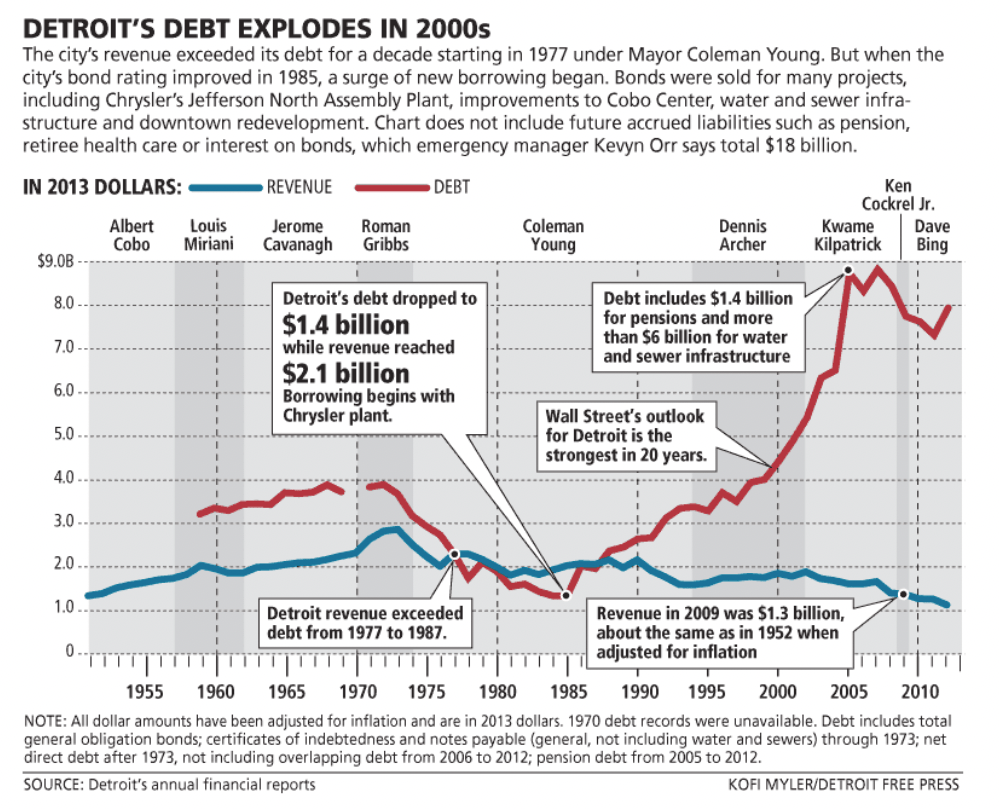
Coleman Young and all subsequent Mayors of Detroit were black. Notice what happened to Detroit’s public finances during this time. While Detoit’s tax revenues kept declining, it ran up disproportionate public debt — until it was moved into bankruptcy.
City Example #6: What Happened to Pittsburg?
Pittsburg experienced the same manufacturing pressures as the other Midwest cities. However, It never experienced a steep decline.
Why?
Well, the following demographic change table tells the story of why.

In 2020, the white population had declined by 20 percentage points from its high in 1950. However, while the black population did increase, it is still roughly 1/3 of the white population. This ratio means that blacks are still a minority group. However, the future of Pittsburg does not look good. Pittsburg looks to continue to have white flight, although, for ten years, the white population has stabilized.
City Example #7: What Happened to Minneapolis?
Minneapolis never had the high concentration of manufacturing jobs of other cities in the Midwest. Therefore, it maintained a higher white population longer than other cities like Cleveland or Detroit. Minneapolis, thus, did not develop the bad reputations of its nearby major cities.

However, notice how the demographics are still changing. Minneapolis has had a significant white flight from 1970 and particularly after 1990. Blacks from other cities in the Midwest have moved to Minneapolis to get away from their degraded black cities. Minneapolis is very close to these cities and a natural place to move to. As with Pittsburg, Minneapolis is going through the process of being degraded by blacks later than the other cities that already have established reputations as bad cities. After the George Floyd riots, large areas of downtown Minneapolis were set on fire by mostly black protesters. I visited Minneapolis a little after the protests. I can attest to the fact that blacks are in the process of incredibly degrading Minneapolis.
Cleveland and St Louis are the futures that Pittsburg and Minneapolis can look forward to.
A National Issue
This article has focused thus far on the Midwest and challenged the claim that the enormous decline of this region is due exclusively to “deindustrialization” and has nothing to do with the migration of blacks to the Midwest.
However, this same issue is repeated in many cities, not in the Midwest.
City Example #8: The Similar Decline of Baltimore
Baltimore went through the same things as the many cities of the Midwest. Like many Midwestern cities, Baltimore was at one time a major manufacturing center of the US. In 1940, whites were 80.6% of the population, and the city was doing well. However, in 2020, Baltimore is only 27.6% white and 62.4% black — and Baltimore is considered a punchline –with a vast no-go zone.

Baltimore and Crime
Due to black crime in Baltimore, the city is known for mass surveillance. The following graphic is from an article on this exact topic.

The following quotes on Baltimore are from the article on Baltimore in Wikipedia.
Baltimore reached a peak population of 949,708 at the official 1950 U.S. census count. In every official ten-year census count since then, the city has lost population, with its 2020 census population at 585,708. In 2011, then-Mayor Stephanie Rawlings-Blake said one of her goals was to increase the city’s population by improving city services to reduce the number of people leaving the city and by passing legislation protecting immigrants’ rights to stimulate growth.
This is not going to work. Whites are leaving the city because the city has become black-dominant and black-run. At that point, leaving is the best option for all racial groups.
Baltimore is identified as a sanctuary city. In 2019, then-Mayor Jack Young said that Baltimore will not assist ICE agents with immigration raids.
Baltimore City’s population has declined overall from 620,961 in 2010 to 585,708 in 2020, representing a 5.7% drop. In 2020, Baltimore lost more population than any other major city in the United States.
This is the norm. When a city has a high percentage of the black population, the city’s population declines.
See the graph of Gary, Indiana. Once an area becomes predominantly black, the population declines due to white flight, the flight of other races, and, eventually, black flight.
Once a predominantly industrial town, with an economic base focused on steel processing, shipping, auto manufacturing (General Motors Baltimore Assembly), and transportation, the city experienced deindustrialization, which cost residents tens of thousands of low-skill, high-wage jobs.
The city now relies on a low-wage service economy, which accounts for 31% of jobs in the city.
This is the standard or establishment explanation. However, this same thing has happened to any city that moved from predominantly white to predominantly black. With such a large black population, having highly skilled jobs becomes no longer possible.
Considering the Black Devastation on Baltimore’s Inner Harbor
The following quote from Wikipedia explains the rapid decline of Baltimore’s Inner Harbor. The Inner Harbor was one of the few tourist attractions that Baltimore had — that is, until blacks began to go there.
Baltimore’s history and attractions have made it a popular tourist destination. In 2014, the city hosted 24.5 million visitors, who spent $5.2 billion. The Baltimore Visitor Center, which is operated by Visit Baltimore, is located on Light Street in the Inner Harbor. Much of the city’s tourism centers around the Inner Harbor, with the National Aquarium being Maryland’s top tourist destination.
This was true in 2014. However, black vandalism and mistreatment of the Inner Harbor have dramatically decreased tourism to Baltimore since this quote was written.
As soon as blacks begin to frequent a tourist area, that tourist area ceases to be an area that can draw in other tourists.
This is a quote from someone who used to visit the Inner Harbor.
The Inner Harbor was built up to attract tourists in the early ’80s. Forty years later businesses are leaving due to a decrease in tourists and an increase in crime. Baltimore has been in decline for years. Now, it’s a dying city on its last leg.
I wouldn’t be surprised if the Inner Harbor ends up being practically a ghost town in the future.
Again — why is it dying?
Why are all the cities that have large black populations categorized as dying?
Here, we have an area that is tourism. The Inner Harbor is not a manufacturing area; its decline cannot be blamed on “deindustrialization.” The reason for the Inner Harbor’s decline is the black population.
The Example of the Black Devastation of Buckhead, Atlanta
Atlanta used to have a very well-known and active nightclub area in Buckhead. However, in the early 2000s, blacks began to go there, which led to fights and shootings. To address the issue politically correctly, the nightclubs were shut down, and the area was converted to high-end shopping. This eliminated blacks’ interest in visiting Buckhead, and the city became civilized again. Baltimore has not learned this lesson. They continue to allow blacks to visit the Inner Harbor, which means that the Inner Harbor will cease to be a destination for any groups but blacks.
City Example #9: Similar Decline in Philadelphia
Philadelphia is also not in the Midwest — however, the same pattern repeats.
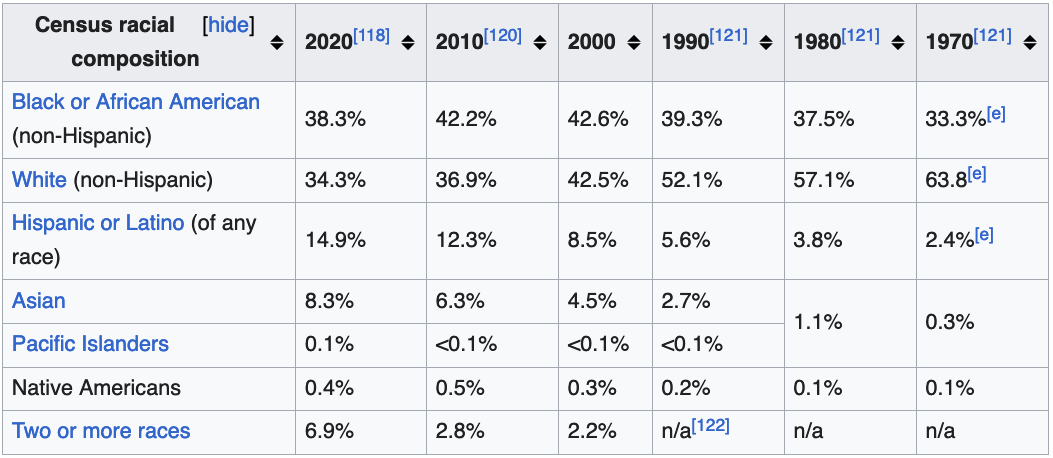
In 1970, the city was 63% white; in 2020, it had fallen to 34.3% white. On the other hand, Blacks have gone from 33.3% to 38.3%. This is a less drastic change — however, the migration to Philadelphia happened earlier. The higher the black percentage versus the white percentage, the worse that city will be. In 1970, at least the whites outnumbered blacks by almost two to one. Now, blacks outnumber whites in Philadelphia. Philadelphia’s reputation is so bad that a black comedy sitcom called itself “Its Alwasy Sunny in Philadelphia,” a poke at Philadelphia’s reputation. If Philadelphia were nearly white, the show would unlikely have been named for the city.
City Example #10: Similar Decline in Wilmington, Delaware
Wilmington is one of those cities that flies under the radar. However, it is yet another example of what happens when blacks become a substantial percentage of a city’s population. Notice below the population decline in the white population from 2000 to 2020. Blacks have been the dominant ethnic group in Delaware for decades. However, blacks had nothing to do with building Delaware into the city it became. Delaware is a late-stage city; this is where most of the white population has already left, and as there is less that can be parasitized, the black population will probably start to leave as well.
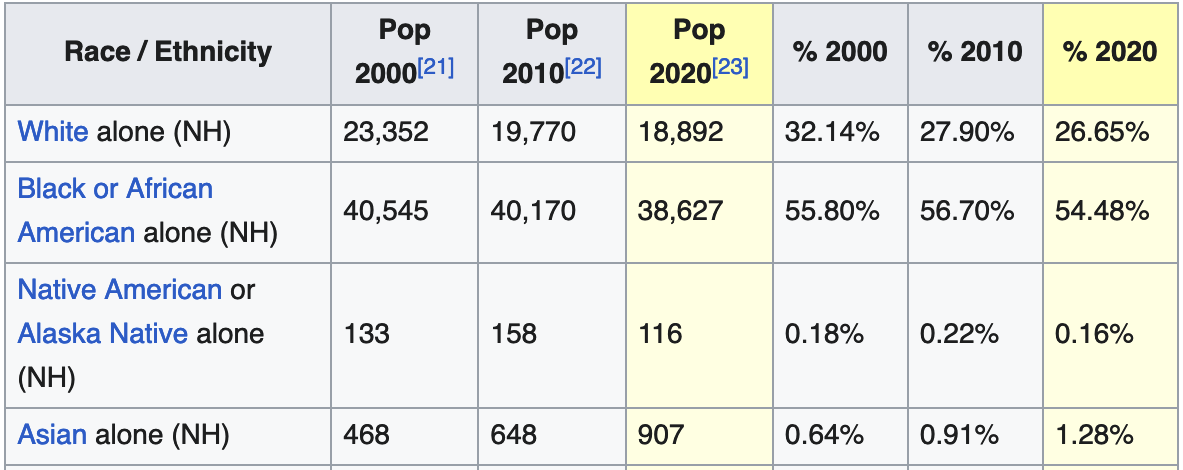
Notice the growth of the overall city’s population below. The city reached its maximum size in 1940, with 112,504 people. However, by 1950, the population has begun to decline. This is likely because black migration to Wilmington makes the city less desirable. By 1980, the population has declined by roughly 42,000, shrinking by 37.5%. This was due to white flight, as blacks made Wilmington less desirable. As there are fewer whites, the average behavior level declines, crime increases, and destructive policies are enacted by an increasing number of blacks in political positions, worsening the situation.
The Effect of White Flight on Blacks
The original reason that blacks moved to Wilmington was to extract from what whites built. With fewer whites, and most of them behind gates or otherwise restricting their interaction with blacks due to fear of being parasitized, this gives blacks less to extract. Trust has been ruined in Wilmington due to blacks.
Moving to Parasitizing the US Government
After the blacks can no longer parasitize whites, they move to parasitize the US government and absorb a very high percentage of the available welfare benefits. Blacks have shown a willingness to reproduce multiple generations based on government handouts.
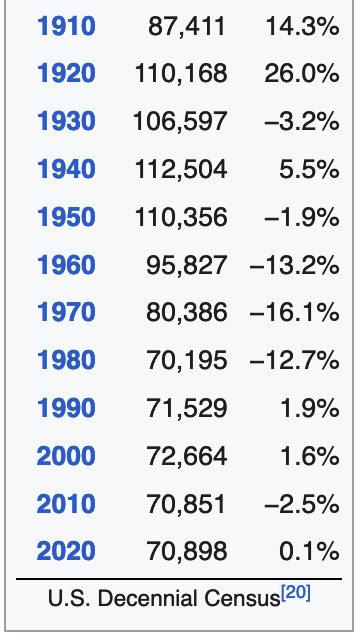
The result is a city that was built by whites ends up being handed over to blacks, and the city falls off of the list of towns that anyone wants to visit. Blacks then say they need more government support and then complain of racial discrimination.
As a dead city, Wilmington moves to be a location for companies from other states to incorporate out of. This reduces the taxes to other states. Another thing Wilmington does is export usury laws from Delaware to other states through its laws. This means that a person who has a credit card in Nebraska from a credit card company incorporated in Wilmington is subject to the non-existant usury laws of Delaware rather than the usury laws of Nebraska. As blacks became parasites in Wilmington, Wilmington became a parasite in other states.
City Example #11: Similar Decline in Camden, New Jersey
Notice the decline of whites from 1950 to 2010. Whites made Camden pleasant, and blacks, as parasites, were attracted to what whites created. By 1970, a white flight was underway; by 1990, it was a runaway train. In my lifetime, Camden has always been known as a no-go zone and a punchline. These tables are from Wikipedia.
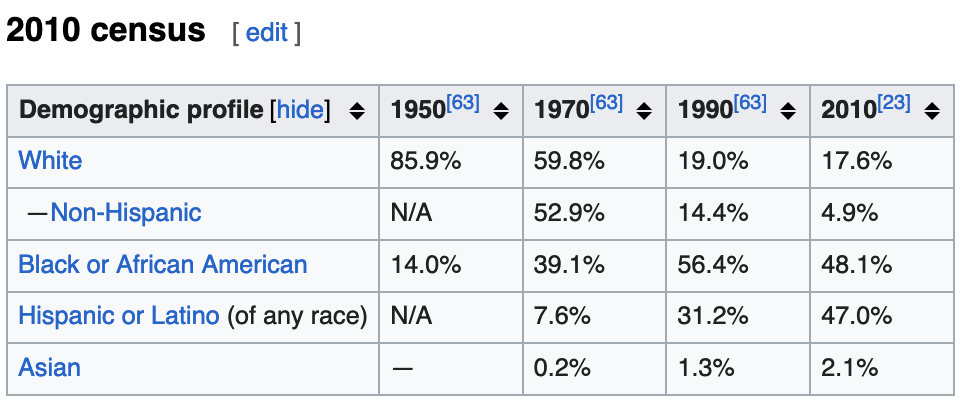
Let’s review the next demographic table, which takes us to 2020.
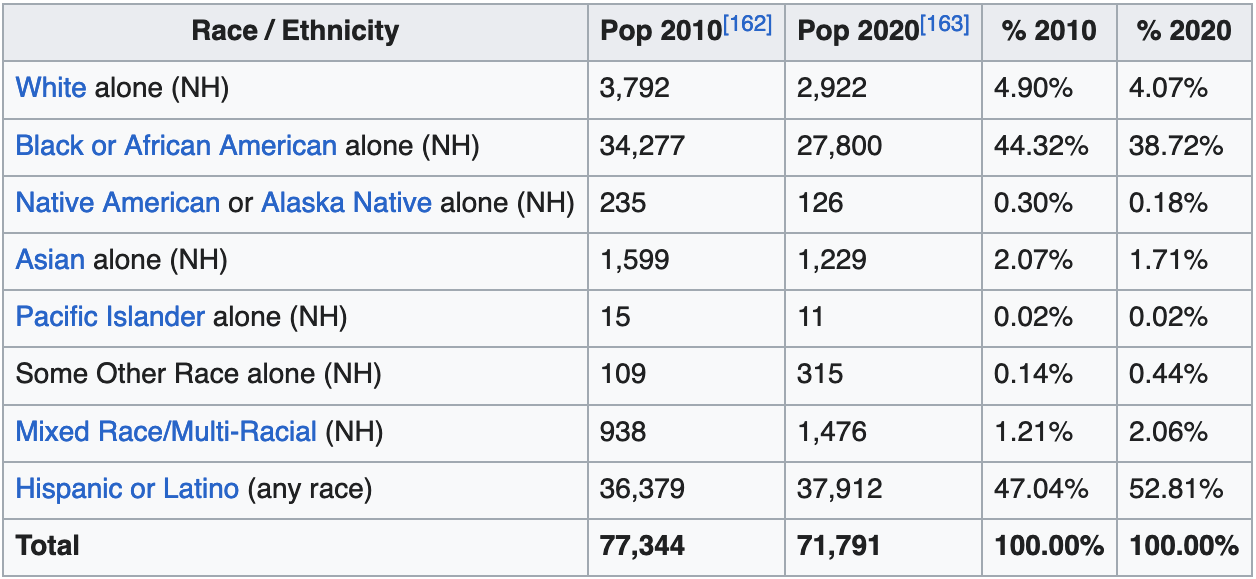
By 2020, whites are nearly absent from Camden. But by 2020, the Latino population is at 52%, and the blacks have declined in absolute number from 34,277 to 27,800. Without the whites to parasitize, it’s time for the blacks to leave Camden to ruin other cities. Latinos with very low standards will actually move into areas ruined by blacks. Camden’s violent crime levels have decreased because Latinos are less violent than blacks.
The following is a whitewashed explanation of what has happened to Camden.
Camden’s cultural history has been greatly affected by both its economic and social position over the years. From 1950 to 1970, industry plummeted, resulting in close to 20,000 jobs being lost for Camden residents.
As with all coverage of black-ruined cities, the fact that this was an intense period of black migration to Camden is left out of why industry plummeted. From 1950 to 1970 the black percentage of the city’s population went from 14% to 39%. No city with such a high percentage of blacks has ever proven sustainable.
This mass unemployment as well as social pressure from neighboring townships caused an exodus of citizens, mostly white.
Really? It was entirely due to unexplained economic causes, which the dramatically increased black population had nothing to do with – even though this same pattern has been repeated in countless cities.
This gap was filled by new African American and Latino citizens and led to a restructuring of Camden’s communities. The number of White citizens who left to neighboring towns such as Collingswood or Cherry Hill left both new and old African American and Latino citizens to re-shape their community.
Why did they leave? Isn’t diversity (non whites that is) a strength?
To help in this process, numerous not-for-profit organizations such as Hopeworks or the Neighborhood Center were formed to facilitate Camden’s movement into the 21st century.
This is not going to do anything. The fact remains that what made Camden sustainable was whites. Blacks came and ruined that and now Latinos are picking up the pieces and the city will function at some degenerated Latino+Black level. This will never return Camden to what it was. With a white population percentage at 4% Camden (and still declining) is now a third world country — and is doubtlessly a net recipient of federal tax dollars rather than a contributor to the federal government. The politicians of Camden will be a combination of black and Latino, both of which have no idea how to run an advanced society.
City Example #12: Similar Decline in Pine Bluff – Arkansas
This video notes Pine Bluff’s decline into being a punchline and all the same things happening to Pine Bluff that happen to all cities with a significant black population — but never once blames blacks for the decline. In every case, the cross-city comparison that could be performed with other cities that became black is never done, and in each case, other reasons are blamed for the cities’ decline.
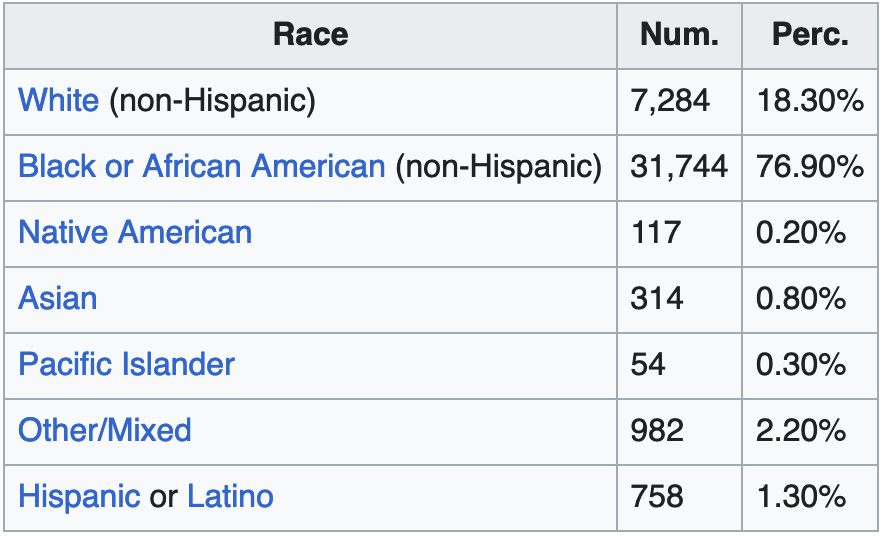
Pine Bluff, AR, is about as black as Detroit. No city with such a high black population is sustainable. As with the other towns, Pine Bluff was built up and made nice by whites and then degraded into horrid conditions by blacks. No matter how many times this pattern repeats itself — the obvious cause — blacks are left out of the analysis. Blacks have not been held responsible for all the US cities and towns they have ruined by moving to them.
Country Example #1: Why Did Zimbabwe “De-Industrialize”
The constant explanation for the decline of the Midwest is that it was due to foreign competition in the key manufacturing areas of the Midwestern cities. However, de-industrialization is not only caused by foreign competition. At the 22:30 mark in the video — it is explained that mismanagement by the Mugabe regime in Zimbabwe led to..
Rapid de-industrialization as production ceased and imports rose. One after another public services like electricity, sewage, transportation, schools and hospitals crumbed as by the time they received funding, the money had already depreciated to almost nothing. Many professionals foreseeing a grim future fled the nation, leading to crumbling infrastructure and an alarming deficit of doctors and teachers.
This occurred when Zimbabwe moved from being white-run to being black-run. Any country or city that is black-run will end up being “de-industrialized” because industrialization is a function of a society that is beyond what blacks can manage. Blacks invented nothing that is part of industrialization; it was brought to blacks by whites, and blacks think they can manage it as well as whites can. It should be evident that an industrialized society contains inventions, technologies, and organizational structures — none of which were invented by blacks. Furthermore, there has never been a prosperous black society by a white standard.
Therefore, the question of any city that begins as white and is then taken over by blacks is not if it will de-industrialize but when it will de-industrialize. This is another way of saying that blacks can’t manage any society that was initially developed by whites. And it is not only whites. Blacks cannot maintain any society developed by North Asians or many other higher-performing societies. This illustrates that “de-industrialization” is not imposed by outside forces but is principally due to internal performance and behaviors.
Conclusion: Understanding The Black Doom Loop
Political correctness has made my explanation and analysis in this article impossible to explore or even utter. This means that logic is being censored in order so that blacks are not viewed accurately as destroyers of cities. The only time black migration to the city is sustainable is in the early stages. In the early stage, the effective dominant white society masks the dysfunction of the early black migrants. However, as the black population continues to rise — through the success that the early black migrants have. Eventually, the black population increases to a point where both the companies and the population are no longer willing or able to tolerate blacks at the concentrations that they ultimately become. As soon as white companies and the white population withdraw, the city falls into a doom loop, and other excuses are searched for to explain away the fact that black migration had degraded yet another white-originated and white-built city.